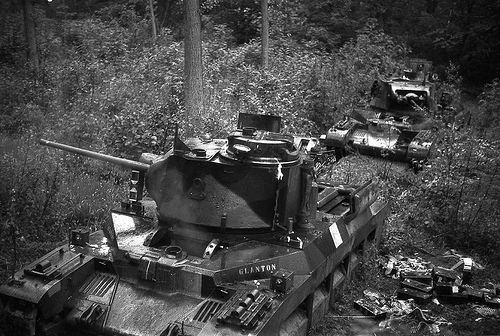By the outbreak of war with Germany in September 1939 there were only two Matildas in service, though 16 had been issued to 7th Royal Tank Regiment in France by early 1940 where they were used with success in the Battle of Arras just prior to the Dunkirk evacuation.
The Matilda is best remembered for its important part in the early Western Desert campaigns. In Libya in 1940 it was virtually immune to any Italian anti-tank gun or tank, and Matildas reigned supreme until the appearance of the German 88mm Flak gun in the anti-tank role in mid-1941, the first gun able to penetrate Matilda’s heavy armour at long range. It was not possible to fit the 6pdr gun in the Matilda (though an attempt was made to mount the A27 type turret on a Matilda chassis), due to the small size of the turret and turret ring. Thus in 1942, the Matilda declined in importance as a gun tank and was last used in action in this role at the first Alamein battle in July 1942.
At Arras the British advance ran into two pieces of bad luck. Rommel was in the vicinity, and the tanks that struck SS Totenkopf hit that division’s antitank battalion. By evening the British had stalled, and the surviving tanks retreated. On the battlefield they had achieved little, but their attack had increased German nervousness and would play a major role in the British Army’s eventual escape. On the 22nd, a small attack from the French V Corps further reinforced OKW fears.
Hitler’s “crisis of nerves” passed and was replaced with unbounded joy when he learned that the pocket-soon to be known as the Dunkirk Pocket-had been closed, and he was brimming over with praise for the army and its leaders. The next day, May 21, he was startled again, however, when two British infantry divisions and the 1st Army Tank Brigade counterattacked against Rommel’s 7th Panzer Division and the Totenkopf (Death’s Head) SS Motorized Division (SS-TK). The British strike force had only 58 Mark Is, armed only with machine guns, and 16 heavy Matilda infantry tanks, but the 30-ton Matildas were superior to any German tank in armored protection and firepower. The right-hand column took Berneville and soon ran into Colonel Georg von Bismarck’s 7th Rifle Regiment, the 1st SS-TK Regiment, and the tank destroyer battalion of the Totenkopf Division, whose shells were unable to penetrate the British tanks. Several SS gun crews were crushed to death under the treads of the Matildas, which were finally brought to a halt by the gunners of the SS-TK artillery regiment, who fired over open sights. Once they were pinned down, the British forces were bombed repeatedly by Stukas. Contrary to the reports of certain historians, the former concentration camp guards did not panic during the British attack; in fact, most of their wounded were hit in the lungs and stomach, because they ran toward the British tanks, trying to knock them out with hand grenades–a brave maneuver, but not a particularly bright one. In his excellent history of the Totenkopf Division, Charles W. Syndor, Jr., concluded that, in general, the division “performed commendably” during the attack.
The British left-hand column hit the 6th Rifle Regiment and initially experienced greater success. Once again, the German 37-millimeter anti-tank guns could not penetrate the thick frontal armor on the British infantry tanks. One Matilda was hit 14 times. They were finally halted by the combined firepower of the 78th Motorized Artillery Regiment, the 86th Light Anti-Tank Battalion (lent to the 7th Panzer by the 4th Army), and elements of the 59th and 23rd Anti-Aircraft Regiments, all firing under the personal supervision of General Rommel. Colonel Rothenburg’s 25th Panzer Regiment then launched a counterattack and forced the British armor nearly back to its starting line. By the end of the day, the 7th Panzer Division had lost 378 men killed, wounded, and missing, as well as nine medium and several light tanks. Theodor Eicke’s SS-TK lost 39 killed, 66 wounded, and two missing.
The Germans pursued the British but were halted by French armour from the 3rd Light Mechanised Division (3rd DLM). The heavier armour of the French saw the German forces stopped cold. French cover enabled British troops to withdraw to their former positions that night. Frankforce took around 400 German prisoners and inflicted a similar number of casualties, as well as destroying a number of tanks. Later on 23 May the 3rd DLM launched its own attack to try to exploit British success. The Luftwaffe and German reinforcements defeated the attack
Both von Kleist and von Kluge were somewhat shaken by the surprisingly aggressive British reaction at Arras. Kluge wanted to delay any further advances until the situation was cleared up and Rundstedt, who wanted to conserve his strength, agreed. The XIX Panzer Corps War Diary records that the British counterattack “apparently created nervousness throughout the entire [Kleist] group area.”
But it went farther than that. Both Hitler and Rundstedt took the attack as an indication that Army Group A had advanced too far, too fast, and needed to establish an adequate defense on the flanks of the Panzer Corridor. Rundstedt therefore ordered Kleist to halt his drive on the Channel ports until the fighting around Arras had been resolved. Ewald von Kleist took the 10th Panzer Division from XIX Panzer Corps and placed it in group reserve. Guderian had earmarked the 10th Panzer for an advance on Dunkirk. This would not be immediately possible.
Even after the Arras counterattack, Rundstedt had seven panzer, six motorized, and four infantry divisions in position to launch an attack into the rear of the B. E. F. At that time, Lord Gort had only two infantry divisions and a few miscellaneous units to protect his right rear. Because it halted the panzers, therefore, the counterattack at Arras represents a significant victory for the British, even though it was undoubtedly a tactical defeat.
